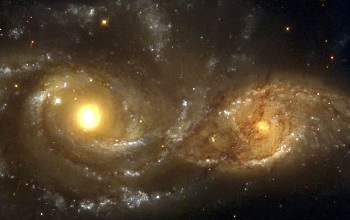|
The spiral galaxies NGC 2207 and IC 2163 are gravitationally locked together, and will slowly pull each other apart over the next few billion years, creating huge sheets of dust and gas, bursts of star formation, and streams of cast-away stars. Their last close encounter was 40 million years ago. NGC 2207, the larger galaxy on the left, will eventually swallow the smaller one on the right.
What happens when two galaxies collide? The changing gravitational fields as galaxies merge cause their shapes to be distorted tremendously, producing vast streams of stars and gas that are hurled into intergalactic space. Most of the matter, however, settles back into a new system which often looks nothing like either of the galaxies before the event. When the interstellar clouds in each of the galaxies collide, they can trigger bursts of star formation, resulting in very massive, short lived, stars being formed. These stars form in large numbers, and their light can combine to turn the galactic collision into a bright event! If the cores of the galaxies have massive black holes, the systems can flare-up into quasar, or near-quasar brilliance for millions of years. The space between stars is so vast, however, that when galaxies collide, the stars in them usually do not themselves collide. Only a few close encounters or impacts, out of literally hundreds of billions of stars, might occur. Planetary orbits could be upset, however, either by the changing galactic gravitational fields or by close encounters with passing stars. |
